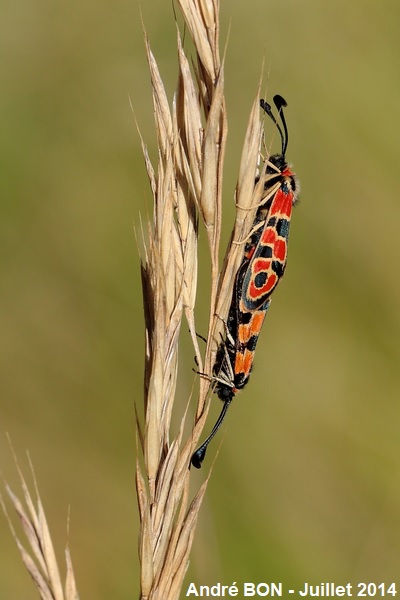


| Chalk Burnet (Zygaena fausta (Linnaeus, 1767)) |



|
|
Scientific name: Zygaena fausta (Linnaeus, 1767) Common name: Chalk Burnet French name: Zygène de la petite coronille, Zygène automnale Order: Lepidoptera Suborder: Heterocera Family: Zygaenidae Subfamily: Zygaeninae Wingspan: 25-30 mm. Biotope: Very dry calcareous places. Geographic area: Western Europe, France, Spain, north of Italy, Switzerland, southern and central Germany. Flight time: May to June then August to September. Number of generations : 2 Caterpillar: Green with short tufts of spines and a yellow dorsal punctuation. Host plant: Coronilla sp. and mainly Coronilla minima. |
The Chalk Burnet is one of the Burnet species showing a red abdominal ring. This ring covers 3 segments on males and only 2 segments on females. However I have read that this abdominal ring may be missing on some subspecies. The back of the head is marked by a red collar. This is a good criteria to tell this species apart. The thorax bears two thin yellow longitudinal bands. The fore wings are black with red or orange red spots outlined with yellow. These spots often extend so that they touch each other. The hind wings are a uniform red colour with a black border. The Merry Burnet (Zygaena hilaris), which is found in the south, does not show any abdominal ring and bears a white collar at the back of the head. |
| [To know more about the Chalk Burnet] [Next picture] [Top] |

|
One red abdominal ring and one red collar, this confirms the Chalk Burnet species. |
| [To know more about the Chalk Burnet] [Next picture] [Previous picture] [Top] |

|
You can clearly see the red collar on this picture. |
| [To know more about the Chalk Burnet] [Previous picture] [Top] |

|
Here is a more distant photo which shows that I have observed one mating. One of the two Burnets is more orange coloured. |